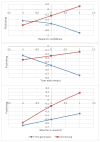The conundrum of social class: Disparities in publishing among STEM students in undergraduate research programs at a Hispanic majority institution
- PMID: 30416213
- PMCID: PMC6224159
- DOI: 10.1002/sce.21330
The conundrum of social class: Disparities in publishing among STEM students in undergraduate research programs at a Hispanic majority institution
Abstract
Research on the science, technology, engineering, and math (STEM) student development pipeline has largely ignored social class and instead examined inequalities based on gender and race. We investigate the role of social class in undergraduate student research publications. Data come from a sample of 213 undergraduate research participants majoring in STEM at a Hispanic-majority institution. Based on generalized estimating equations that adjust for student demographics, research confidence, mentoring experiences, duration/number of research experiences, and clustering by major, we find that higher income students and continuing-generation students (vs. first-generation students) were significantly more likely to publish. Continuing-generation students had an even greater likelihood of publishing than first-generation students as students accrued more research confidence, spent more hours/week with faculty mentors, and conducted research for more months. Results suggest that undergraduate research programs designed to enhance diversity may help close some gaps (e.g., gender) but inadvertently reproduce class inequalities.
Keywords: STEM; first-generation college students; research productivity; social class; undergraduate research.
Conflict of interest statement
CONFLICT OF INTEREST The authors have no conflicts of interest to declare.
Figures


Similar articles
-
Undergraduate research experiences: mentoring, awareness, and perceptions-a case study at a Hispanic-serving institution.Int J STEM Educ. 2018;5(1):9. doi: 10.1186/s40594-018-0105-8. Epub 2018 Apr 2. Int J STEM Educ. 2018. PMID: 30631699 Free PMC article.
-
Increasing Research Productivity in Undergraduate Research Experiences: Exploring Predictors of Collaborative Faculty-Student Publications.CBE Life Sci Educ. 2017 Fall;16(3):ar42. doi: 10.1187/cbe.16-11-0326. CBE Life Sci Educ. 2017. PMID: 28747352 Free PMC article.
-
Navigating Social Relationships with Mentors and Peers: Comfort and Belonging among Men and Women in STEM Summer Research Programs.CBE Life Sci Educ. 2019 Jun;18(2):ar17. doi: 10.1187/cbe.18-08-0150. CBE Life Sci Educ. 2019. PMID: 31025915 Free PMC article.
-
The effects of flipped classrooms to improve learning outcomes in undergraduate health professional education: A systematic review.Campbell Syst Rev. 2023 Jul 7;19(3):e1339. doi: 10.1002/cl2.1339. eCollection 2023 Sep. Campbell Syst Rev. 2023. PMID: 37425620 Free PMC article. Review.
-
Using Drosophila Oogenesis in the Classroom to Increase Student Participation in Biomedical Research.Methods Mol Biol. 2023;2626:381-398. doi: 10.1007/978-1-0716-2970-3_21. Methods Mol Biol. 2023. PMID: 36715917 Review.
Cited by
-
Increasing Clinician-Scientist Workforce Diversity through the National Institute of General Medical Sciences' Medical Scientist Training Program.ATS Sch. 2022 Sep 7;3(3):358-378. doi: 10.34197/ats-scholar.2022-0018PS. eCollection 2022 Oct. ATS Sch. 2022. PMID: 36312807 Free PMC article.
-
Internet-connected cortical organoids for project-based stem cell and neuroscience education.bioRxiv [Preprint]. 2023 Jul 15:2023.07.13.546418. doi: 10.1101/2023.07.13.546418. bioRxiv. 2023. Update in: eNeuro. 2023 Dec 26;10(12):ENEURO.0308-23.2023. doi: 10.1523/ENEURO.0308-23.2023. PMID: 37503236 Free PMC article. Updated. Preprint.
-
A Community-Based, Culturally Engaging STEM Learning Environment and Its Impact on Students' Psychosocial Attributes at a Rural Hispanic Serving Institution (HSI).CBE Life Sci Educ. 2024 Dec;23(4):ar62. doi: 10.1187/cbe.23-12-0238. CBE Life Sci Educ. 2024. PMID: 39576940 Free PMC article.
-
Advancing Diversity in Behavior Genetics: Strategies for Incorporating Undergraduates into Student-Driven Research.Behav Genet. 2024 Jan;54(1):4-23. doi: 10.1007/s10519-023-10172-9. Epub 2024 Jan 22. Behav Genet. 2024. PMID: 38252380
-
Engaging with CC Bio INSITES: Experiences of Barriers, Supports, and Belonging in Community College Faculty Participating in Biology Education Research.CBE Life Sci Educ. 2022 Jun;21(2):ar16. doi: 10.1187/cbe.21-09-0246. CBE Life Sci Educ. 2022. PMID: 35580007 Free PMC article.
References
-
- Abel T. Cultural capital in health promotion. In: McQueen DV, Kickbush I, editors. Health and modernity: The role of theory in health promotion. New York, NY: Springer; 2007. pp. 43–73.
-
- Allison PD. Imputation of categorical variables with PROC MI. SUGI 30 Proceedings. 2005;113(30):1–14.
-
- Astin AW, Antonio AL. Assessment for excellence: The philosophy and practice of assessment and evaluation in higher education. Lanham, MD: Rowman & Littlefield; 2012.
-
- Bailey TG. Faculty research productivity. Paper presented at the Minneapolis, MN: Association for the Study of Higher Education Annual Meeting; 1992. Retrieved from ERIC (ED352895)
Grants and funding
LinkOut - more resources
Full Text Sources
